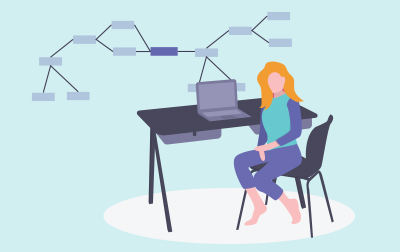Mastering Microservices with Spring Boot and Spring Cloud Training (SPR112)
Course Length: 4 days
This Mastering Microservices with Spring Boot and Spring Cloud Training class introduces Spring Boot, Spring Cloud, and the Netflix OSS suite as a way of deploying highly resilient and scalable RESTful services and web applications.

Register or Request Training
- Private class for your team
- Live expert instructor
- Online or on‑location
- Customizable agenda
- Proposal turnaround within 1–2 business days
Course Overview
This Mastering Microservices with Spring Boot and Spring Cloud Training class introduces Spring Boot, Spring Cloud, and the Netflix OSS suite as a way of deploying highly resilient and scalable RESTful services and web applications.
Course Benefits
- Create Spring Boot projects.
- Use databases and JPA in Spring Boot.
- Create RESTful services with Spring Boot.
- Deploy services that use Netflix Eureka, Hystrix, and Ribbon to create resilient and scalable services.
Delivery Methods
Course Outline
- Introduction to the Spring Framework
- What is the Spring Framework?
- Spring Philosophies
- Why Spring?
- Spring Modules
- Requirements and Supported Environments
- Using Spring with Servers
- Role of Spring Container
- Spring Example
- Avoiding Dependency on Spring
- Additional Spring Projects/Frameworks
- Summary
- Spring Annotation Configuration
- Spring Containers
- Annotation-based Spring Bean Definition
- Scanning for Annotation Components
- Defining Component Scope Using Annotations
- JSR-330 @Named Annotation
- JSR-330 @Scope
- Annotation-based Dependency Injection
- Wiring Bean using @Inject
- @Autowired - Constructor
- @Autowired – Field
- @Autowired - method
- @Autowired – Collection
- @Autowired – Maps
- @Autowired & @Qualifier with Constructors, Fields, and Methods
- @Autowired & Custom Qualifiers
- @Autowired & Simple Custom Qualifier Field
- @Autowired & Simple Custom Qualifier Method
- @Autowired & CustomAutowireConfigurer
- Dependency Injection Validation
- @Resource
- @PostConstruct and @PreDestroy
- Summary
- Spring Framework Configuration
- Java @Configuration Classes
- Defining @Configuration Classes
- Loading @Configuration Classes
- Modularizing @Configuration Classes
- Qualifying @Bean Methods
- Trouble with Prototype Scope
- Configuration with Spring Expression Language
- Resolving Text Messages
- Spring Property Conversion
- Spring Converter Interface
- Using Custom Converters
- Spring PropertyEditors
- Registering Custom PropertyEditors
- Summary
- Introduction to Spring Boot
- What is Spring Boot?
- Spring Boot Main Features
- Spring Boot on the PaaS
- Understanding Java Annotations
- Spring MVC Annotations
- Example of Spring MVC-based RESTful Web Service
- Spring Booting Your RESTful Web Service
- Spring Boot Skeletal Application Example
- Converting a Spring Boot Application to a WAR File
- Externalized Configuration
- Starters
- The 'pom.xml' File
- Spring Boot Maven Plugin
- HOWTO: Create a Spring Boot Application
- Summary
- Spring MVC
- Spring MVC
- Spring Web Modules
- Spring MVC Components
- DispatcherServlet
- Template Engines
- Spring Boot MVC Example
- Spring MVC Mapping of Requests
- Advanced @RequestMapping
- Composed Request Mappings
- Spring MVC Annotation Controllers
- Controller Handler Method Parameters
- Controller Handler Method Return Types
- View Resolution
- Spring Boot Considerations
- Summary
- Overview of Spring Boot Database Integration
- DAO Support in Spring
- Spring Data Access Modules
- Spring JDBC Module
- Spring ORM Module
- DataAccessException
- @Repository Annotation
- Using DataSources
- DAO Templates
- DAO Templates and Callbacks
- ORM Tool Support in Spring
- Summary
- Using Spring with JPA or Hibernate
- Spring JPA
- Benefits of Using Spring with ORM
- Spring @Repository
- Using JPA with Spring
- Configure Spring Boot JPA EntityManagerFactory
- Application JPA Code
- "Classic" Spring ORM Usage
- Spring JpaTemplate
- Spring JpaCallback
- JpaTemplate Convenience Features
- Spring Boot Considerations
- Spring Data JPA Repositories
- Summary
- Introduction to MongoDB
- MongoDB
- MongoDB Features
- MongoDB's Logo
- Positioning of MongoDB
- MongoDB Applications
- MongoDB Data Model
- MongoDB Limitations
- MongoDB Use Cases
- MongoDB Query Language (QL)
- The CRUD Operations
- The
- find
- Method
- The
- findOne
- Method
- A MongoDB QL Example
- Data Inserts
- MongoDB vs Apache CouchDB
- Summary
- Working with Data in MongoDB
- Reading Data in MongoDB
- The Query Interface
- Query Syntax is Driver-Specific
- Projections
- Query and Projection Operators
- MongoDB Query to SQL Select Comparison
- Cursors
- Cursor Expiration
- Writing Data in MongoDB
- An Insert Operation Example
- The Update Operation
- An Update Operation Example
- A Remove Operation Example
- Limiting Return Data
- Data Sorting
- Aggregating Data
- Aggregation Stages
- Accumulators
- An Example of an Aggregation Pipe-line
- Map-Reduce
- Summary
- Spring Data with MongoDB
- Why MongoDB?
- MongoDB in Spring Boot
- Pom.xml
- Application Properties
- MongoRepository
- Custom Query Methods
- Supported Query Keywords
- Complex Queries
- Create JavaBean for Data Type
- Using the Repository
- Summary
- Spring REST Services
- Many Flavors of Services
- Understanding REST
- RESTful Services
- REST Resource Examples
- REST vs SOAP
- REST Services With Spring MVC
- Spring MVC @RequestMapping with REST
- Working With the Request Body and Response Body
- @RestController Annotation
- Implementing JAX-RS Services and Spring
- JAX-RS Annotations
- Java Clients Using RestTemplate
- RestTemplate Methods
- Summary
- Spring Security
- Securing Web Applications with Spring Security 3.0
- Spring Security 3.0
- Authentication and Authorization
- Programmatic v Declarative Security
- Getting Spring Security from Maven
- Spring Security Configuration
- Spring Security Configuration Example
- Authentication Manager
- Using Database User Authentication
- LDAP Authentication
- Summary
- Spring JMS
- Spring JMS
- JmsTemplate
- Connection and Destination
- JmsTemplate Configuration
- Transaction Management
- Example Transaction Configuration
- Producer Example
- Consumer Example
- Converting Messages
- Message Listener Containers
- Message-Driven POJO's Async Receiver Example
- Message-Driven POJO's Async Receiver Configuration
- Spring Boot Considerations
- Summary
- Microservices
- What is a "Microservice"?
- One Helpful Analogy
- SOA - Microservices Relationship
- ESB - Microservices Relationship
- Traditional Monolithic Designs and Their Role
- Disadvantages of Monoliths
- Moving from a Legacy Monolith
- When Moving from a Legacy Monolith
- The Driving Forces Behind Microservices
- How Can Microservices Help You?
- The Microservices Architecture
- Utility Microservices at AWS
- Microservices Inter-connectivity
- The Data Exchange Interoperability Consideration
- Managing Microservices
- Implementing Microservices
- Embedding Databases in Java
- Microservice-Oriented Application Frameworks and Platforms
- Summary
- Spring Cloud Config
- The Spring Cloud Configuration Server
- Why Configuration Management is Important
- Configuration Management Challenges in Microservices
- Separation of Configuration from Code
- Configuration Service
- How the Configuration Service Works
- Cloud Config Server Properties File
- Git Integration
- Properties
- Configuration Client
- Sample Client Config File
- Sample Client Application
- Dynamic Property Updates – Server
- Dynamic Property Update – Client
- Dynamic Property Update – Execute
- Summary
- Service Discovery with Netflix Eureka
- Service Discovery in Microservices
- Load Balancing in Microservices
- Netflix Eureka
- Eureka Architecture
- Communications in Eureka
- Time Lag
- Eureka Deployment
- Peer Communication Failure between Servers
- Eureka Server Configuration
- Eureka Client/Service
- Eureka Client Properties
- Spring Cloud DiscoveryClient Interface
- ServiceInstance JSON
- ServiceInstance Interface
- What about Services
- Eureka and the AWS Ecosystem
- Summary
- Load-Balancing with Netflix Ribbon
- Load Balancing in Microservices
- Netflix Ribbon
- Server-side load balance
- Client-side Load Balance
- Architecture
- Load Balance Rules
- RoundRobinRule
- AvailabilityFilteringRule
- WeightedResponseTimeRule
- RandomRule
- ZoneAvoidanceRule
- IPing Interface (Failover)
- Using Ribbon
- YAML Configuration
- Configuration Class
- Client Class
- Client Class Implementation
- Integration with Eureka (Service Discovery)
- Using Ribbon in the Amazon AWS Cloud
- Summary
- Application Hardening with Netflix Hystrix
- Netflix Hystrix
- Design Principles
- Design Principles (continued)
- Cascading Failures
- Bulkhead Pattern
- Circuit Breaker Pattern
- Thread Pooling
- Request Caching
- Request Collapsing
- Fail-Fast
- Fallback
- Using Hystrix
- Circuit Breaker Configuration
- Fallback Configuration
- Collapser Configuration
- Rest Controller and Handler
- Collapser Service (Part 1)
- How the Collapser Works
- Hystrix Monitor
- Enable Monitoring
- Turbine
- The Monitor
- Monitor details
- Summary
- Edge Components with Netflix Zuul
- Zuul is the Gatekeeper
- Request Handling
- Filters
- Filter Architecture
- Filter Properties
- filterType()
- filterOrder()
- shouldFilter()
- Run()
- Cancel Request
- Dynamic Filter Loading
- Filter Communications
- Routing with Eureka and Ribbon
- Summary
- Distributed Tracing with Zipkin
- Zipkin
- Zipkin Features
- Architecture
- The Collector
- Storage
- API
- GUI Console
- Zipkin Console Homepage
- View a Trace
- Trace Details
- Dependencies
- Dependency Details
- Zipkin in Spring Boot
- Zipkin Configuration
- Summary
Class Materials
Each student receives a comprehensive set of materials, including course notes and all class examples.
Class Prerequisites
Experience in the following is required for this Spring class:
- Experience with Java development.
Have questions about this course?
We can help with curriculum details, delivery options, pricing, or anything else. Reach out and we’ll point you in the right direction.
